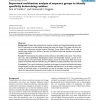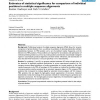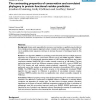32 search results - page 2 / 7 » Prediction and analysis of nucleotide-binding residues using... |
BMCBI
2008
13 years 5 months ago
2008
Background: The prediction of conformational B-cell epitopes is one of the most important goals in immunoinformatics. The solution to this problem, even if approximate, would help...
CSB
2003
IEEE
13 years 10 months ago
2003
IEEE
Recognition of a protein’s fold provides valuable information about its function. While many sequence-based homology prediction methods exist, an important challenge remains: tw...
BMCBI
2007
13 years 5 months ago
2007
Background: Proteins that evolve from a common ancestor can change functionality over time, and it is important to be able identify residues that cause this change. In this paper ...
BMCBI
2004
13 years 5 months ago
2004
Background: Profile-based analysis of multiple sequence alignments (MSA) allows for accurate comparison of protein families. Here, we address the problems of detecting statistical...
BMCBI
2008
13 years 5 months ago
2008
Background: Amino acids responsible for structure, core function or specificity may be inferred from multiple protein sequence alignments where a limited set of residue types are ...




